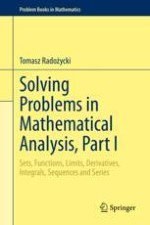This textbook offers an extensive list of completely solved problems in mathematical analysis. This first of three volumes covers sets, functions, limits, derivatives, integrals, sequences and series, to name a few. The series contains the material corresponding to the first three or four semesters of a course in Mathematical Analysis.
Based on the author’s years of teaching experience, this work stands out by providing detailed solutions (often several pages long) to the problems. The basic premise of the book is that no topic should be left unexplained, and no question that could realistically arise while studying the solutions should remain unanswered. The style and format are straightforward and accessible. In addition, each chapter includes exercises for students to work on independently. Answers are provided to all problems, allowing students to check their work.
Though chiefly intended for early undergraduate students of Mathematics, Physics and Engineering, the book will also appeal to students from other areas with an interest in Mathematical Analysis, either as supplementary reading or for independent study.
